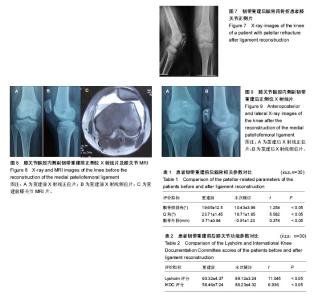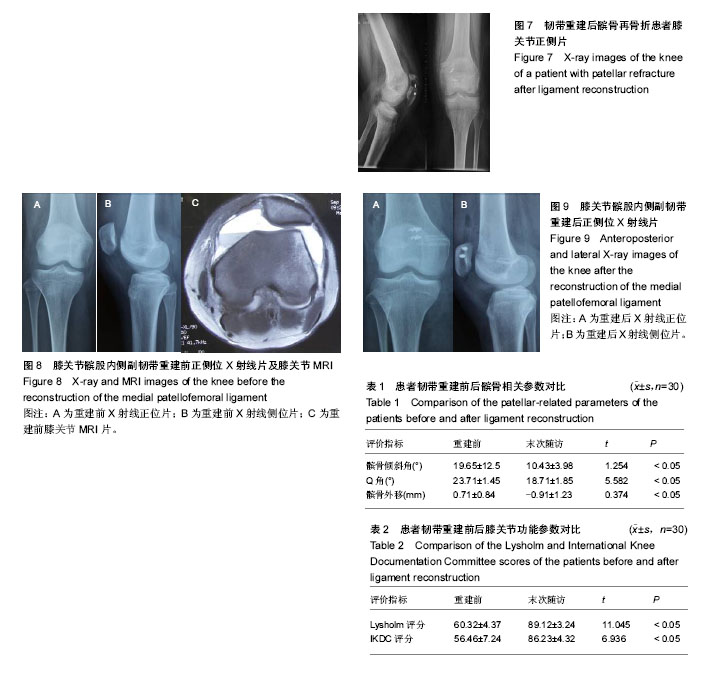| [1] Bitar AC,Demange MK,D,Elia CO, et al. Traumatic patellar dialcation nonperative treatment compared with MPFL reconstruction using patellar tendon. Am J Sports Med. 2012 ; 40(1):114-122.[2] Senavongse W,Amis AA.The effects of articular, retinacular or muscular deficiencies on patelofemoral joint stability.Bone Joint Surg Br.2005;87(4):577-582.[3] Ohashi K,Sanghvi T,El-Khoury GY,et al.Diagnostic accuracy of SD color volume-rendered CT images for peroneal tendon dislocation in patients with acute calcaneal fractures.Acta Radiol.2015;56(2):190-195.[4] Bicos J,Fulkerson JP,Anis A.Currents review: the medial patellofemoral ligament. Am J Sports Med.2007; 35(3):484-492.[5] 陈辉,王群,燕双喜,等.外侧支持带松解联合髌骨韧带重建修复复发性髌骨脱位[J].中国组织工程研究,2015,19(29):4747-4751.[6] Lin KY,LU Yc,Renn JH,et al.The double-pulley technique for anatomical double-bundled medial patellofemoral ligament reconstruction.Injury.2015;46(8):1619-1624.[7] Stephen JM,Dodds AL,Lumpaopong P,et al.The ablity of medial patellofemoral ligament reconstruction to correct patellar kinematics tubercle.Am J Sport Med.2015; 43(9):2198-2207.[8] 阮文辉,李宏波,谢鹏,等.成人复发性髌骨脱位的术前影像学评估与联合手术[J].中华骨与关节外科杂志,2016,9(1):57-61.[9] SchÖttle PB,Schmeling A, Rosenstiel N, et al.Radiographic landmarks for femoral tunnel placement in medial patelofemoral ligament reconstruction. Am J Sports Med. 2007;35(5):801-804.[10] Earhart C,Patel DB,White EA,et al.Transient lateral patellar dislocation: review of imaging findings, patellofemoral anatomy, and treatment options.Emergency Radiology.2013;20(1):11-23.[11] 戴祝,尤迪,廖瑛,等.髌骨复发性脱位伴陈旧性骨软骨的治疗[J].中国修复重建外科杂志,2016,30(1):10-14.[12] Seeley MA, Knese KM, Vanderhave KL. Osteochondral injury after acute patellar dislocation in children and adolescent.J Pediatr Orthop.2013;33(5):511-518.[13] Felus J,Kowalczy KB. Age-related differences in medial patellofemoral ligament injury patterns in traumatic patellar dislocation: case series of 50 surgically treated children and adolescents.Am J Sports Med.2012;40(10):2357-2364.[14] Dejour H, Walch G, Nove-Josserand L, et al. Factors of patellar instability : an anatomic radiographic study.Knee Surg Sports Traumatol Arthrosc.1994;2(1):19-26.[15] 李良军,丑克,何志勇,等.MRI对一过性髌骨脱位的诊断价值[J].医学临床研究,2016,33(1):33-36.[16] Oestern S, Varoga D, Lippross S. et al Patella dislocation. Unfall Chirurg. 2011;114(4):345-358.[17] Saccomanno MT,Sircana G,Fodale M,et al. Surgical versus conservative treatment of primary patellar dislocation. A systematic review and meta-analysis.Int Orth,2015, [Epub a head of print].[18] Camanho GL, Viegas AC, Bitar AC, et al.Conservative versus surgical treatment for repair of the medial patellofemoral ligament in acute dislocations of the patella.Arthroscopy. 2009;25(6):620-625.[19] Dele M,Ochi M,Sumen Y,et al.A Long-term follow-up study after medial patellofemoral ligament reconstruction using the transferred semitendinsus tendon for patellar dislocation. Knee Surg Sports Traumatol Arthrosc.2005;13(7):522-528.[20] Maenpaa H,Lehto MU. Patellar dislocation: the long-term results of nonoperative management in 100 patients. Am J Sports Med.1997;25:213-221.[21] Reagan J,Kullar R, Burks R.MPFL reconstruction: technique and results.Orth Clin North Am.2015;46(1):159-169.[22] Hennrikus W,Pylawka T.Patellofemoral instability in skeletally immature athletcs.J Bone Joint Surg Am.2013;95(2):176-183.[23] Enderlein D,Nielsen T,Christiansen SE,et al.Clinical outcome after reconstruction of the medial patellofemoral ligament in patients with recurrent patella instablity. Knee Surg Sports Traumatol Arthrosc.2014;22(10):2458-2464.[24] Cheatham S,Kolber MJ,Hanney WJ.Rehabilitation of a 23-year-old male after right knee arthroscopy and open reconstruction of the medial patellofemoral ligament with a tibialis anterior allograft :a case report.Int J Sports Phys Ther. 2014;9(2) :208-221.[25] Ellera GJ.Medical patellofemoral ligament reconstruction for recurrent dislocation of the patella :a preliminary report. Arthroscopy.1992;8(3):335-340.[26] Miho J,Tanaka, Matthew J,et al. Complications factors for success: AAOS Exhibit Selection. J Bone Joint Surg Am. 2012;94(12):e87.[27] Smirk C,Morris H. The anatomy and reconstruction of the medial patellofemoral ligament. Knee.2003;10(3):221-227.[28] Fithian DC,Gupta N.Patellar instability : Principals of soft tissue and reconstruction.Tech Knee Surg.2006;5(1):19-26.[29] Shah JN, Howard JS, Flanigan DC,et al. A systematic review of complications and failures associated with medial patellofemoral ligament reconstruction for recurrent patellar dislocation. Am J Sports Med.2012;40(8):1916-1923.[30] Fithian DC, Paxton EW, Post WR , et al. Lateral retinacular release: a survey of the intemational patellofemoral study group.Arthroscopy.2004;20(5):463-468.[31] Ricchetti E, Mehta S, Sennett B,et al.Comparison of lateral release versus lateral release with medial soft-tissue realignment for the treatment of recurrent patellar instability :a systematic review.Arthroscopy.2007;23(5):463-468.[32] Hautamaa PA,Ftthiaia DC,Kaufman KR,et al.Medial soft tissue restraints in lateral patellar instability and repair.Clin Ort Relat Res.1998;(349):174-178.[33] Rhee SJ,Pavlou G,Oakley J,et al.Modern management of patellar instability.Int Orthop.2012;36(12):2447-2456. [34] Moitrel G, Roumazeille T , Arnould A, et al. Does severity of femoral trochlear dysplasia affect outcome in patellofemoral instability treat by medial patellofemoral ligament reconstruction and anterior tibial tuberosity transfer?. Orthop Traumatol Surg Res.2015;101(6):693-697. [35] Mehl J, Feucht MJ, Bode G, et al .Association betwwen patellar cartilage defects and patellofemoral geometry : a matched-pair MRI comparison of patients with and without isolated patellar cartilage defects. Knee Surg Sports Traumatol Arthrosc. 2016;24(3):838-846. |

